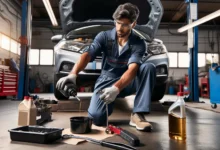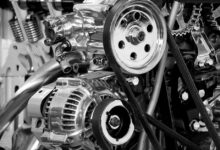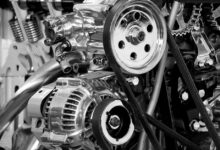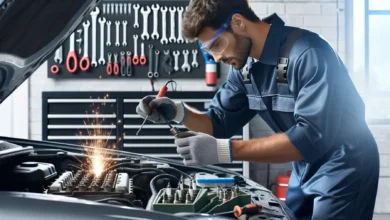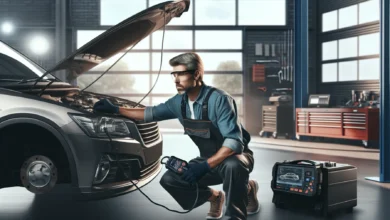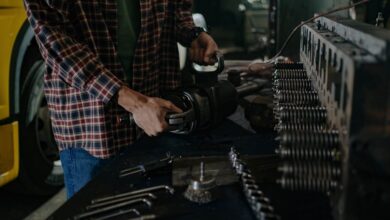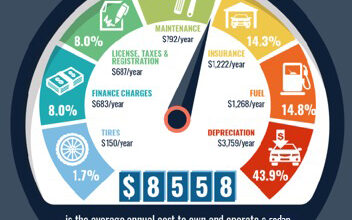Engine Coolant Flush: Why It’s Essential, Benefits, and Step-by-Step Guide for Car Owners
Sponsored Ads
When it comes to keeping my car running smoothly, I know that regular maintenance is key. One task I never overlook is an engine coolant flush. It might sound simple, but this routine service can make a huge difference in how well my engine performs and how long it lasts.
Over time, coolant can break down or get contaminated, putting my engine at risk for overheating and corrosion. I’ve learned that a proper coolant flush helps prevent costly repairs down the road. To keep my vehicle reliable year-round, paying attention to the cooling system is essential.
What Is an Engine Coolant Flush?
An engine coolant flush removes old coolant and contaminants from my vehicle’s cooling system. I drain the current coolant, rinse the system with a cleaning solution, and refill it with fresh coolant. This process eliminates rust, scale, and debris, ensuring optimal temperature control and preventing internal engine corrosion.
When I complete a coolant flush, I protect essential cooling system components. Examples include the radiator, water pump, and heater core. By flushing the system at the manufacturer’s recommended intervals, I maintain efficient engine cooling and avoid overheating risks.
An engine coolant flush provides measurable benefits for my vehicle’s performance. I reduce the chance of overheating, lengthen the life of system components, and optimize heat transfer. Using a flush instead of a simple drain removes more particulates—according to the National Institute for Automotive Service Excellence, flushing can remove up to 95% of old coolant and residue, compared to roughly 40% with a drain-and-fill alone.
Why Perform an Engine Coolant Flush?
I rely on a complete engine coolant flush to maximize the health and efficiency of my cooling system. Removing degraded coolant protects sensitive engine components and ensures stable temperature control.
Benefits of Regular Coolant Flushes
- Enhanced Corrosion Protection: I reduce metal surface corrosion in the radiator and engine block by flushing out acidic residue and contaminants.
- Improved Engine Cooling: I help prevent overheating under high load or summer conditions by ensuring proper coolant flow and efficient heat transfer.
- Longer Component Lifespan: I extend the service life of my vehicle’s water pump, thermostat, and heater core by removing debris and mineral deposits.
- Better System Performance: I maintain high heat dissipation rates and stable operation because fresh coolant keeps the cooling system performing close to original factory conditions.
- Lower Repair Costs: I avoid costly repairs for corroded radiators or engine damage by regularly flushing and refilling with clean coolant.
Risks of Skipping Coolant Maintenance
- Corrosion and Scale Build-Up: I create an environment that fosters the growth of rust and scale inside the cooling system if contaminated coolant remains, potentially causing blockages or leaks.
- Reduced Cooling Efficiency: I risk higher engine temperatures in stop-and-go traffic or warm climates when sludge and particles accumulate, restricting the flow of coolant.
- Component Failure: I experience failures in vital components, such as the thermostat, radiator, and hoses, due to sludge buildup, leading to unexpected breakdowns.
- Expensive Engine Damage: I increase the possibility of overheating-related engine failures and cylinder head warping if the recommended flush intervals are not followed.
- Increased Repair Frequency: I set up recurring maintenance bills for parts that require frequent replacement or cleaning due to corrosion.
| Process | Old Coolant Removed | Residue Eliminated | Protection for Components | Overheating Risk Reduced |
|---|---|---|---|---|
| Engine Coolant Flush | Up to 95% | Yes | High | Substantial |
| Drain-and-Fill | Up to 40% | Partial | Moderate | Limited |
I maintain consistent coolant performance and safeguard my vehicle’s engine by opting for a full flush, rather than leaving contaminants behind.
Materials and Tools Needed for an Engine Coolant Flush
Completing an engine coolant flush with reliable results requires the use of the right materials and equipment. Using specific items eliminates contamination risks and ensures consistent system performance.
Essential Tools and Equipment
- Wrenches and screwdrivers: I use these to remove radiator drain plugs, loosen clamps, and access engine covers as needed for a coolant flush.
- Drain pan (minimum 2-gallon capacity): I collect old coolant safely and prevent environmental contamination by positioning the pan directly under the radiator drain.
- Funnel (with long neck): I fill the radiator or reservoir with coolant and distilled water without spilling during the flush process.
- Garden hose or coolant flush kit: I thoroughly flush debris and residues out of the system, with flush kits offering higher flow control and precision for systems requiring extra cleaning.
- Work gloves and safety goggles: I protect my hands and eyes from hot coolant and possible splashes during draining and refilling procedures.
- Rags or shop towels: I clean spills and wipe down system components to keep the work area tidy.
- Jack and jack stands or ramps: I access the radiator drain more easily after raising the front end safely with these supports.
Recommended Coolant and Fluids
- OEM-approved coolant or antifreeze: I select the correct formula, such as HOAT, OAT, or IAT, by checking the vehicle manufacturer’s recommendations to avoid chemical incompatibility and maximize cooling performance.
- Distilled water (not tap water): I use distilled water for diluting concentrated coolant or for system flushing to prevent mineral buildup in the engine and cooling channels.
- Coolant flush cleaner: I add a flush additive for heavily contaminated systems to dissolve scale and remove stubborn rust, constantly verifying product compatibility with aluminum engine components before use.
- Protective coolant disposal container: I transfer old coolant into a sealed waste container for legal and safe transport to a recycling or collection center.
How to Prepare for an Engine Coolant Flush
Preparation improves the safety and efficiency of an engine coolant flush. My process addresses hazard prevention and provides clear system access to streamline the procedure.
Safety Precautions
I allow the engine to cool completely before beginning work since hot coolant can cause severe burns. I put on protective work gloves and safety goggles to protect my skin and eyes from splashes or spills. I work in a well-ventilated area to avoid breathing in fumes from coolant and cleaning agents. I keep absorbent rags and a spill kit within reach to control accidental spills immediately.
Locating the Radiator and Drain Plug
I open the hood of my vehicle and identify the radiator, which sits at the front of the engine bay, often in front of the engine block and behind the grille. I locate the radiator cap on top and trace the lower radiator hose to find the drain plug at the bottom. If access is obstructed, I lift my vehicle using a jack and secure it with stands or ramps for stable, safe access under the car. I position a drain pan directly underneath the drain plug to collect coolant and prevent spills from occurring.
Step-By-Step Guide to Performing an Engine Coolant Flush
This step-by-step guide ensures an efficient and safe engine coolant flush. I use the tools and materials detailed earlier to prevent mistakes and contamination throughout the process.
Draining the Old Coolant
I confirm my radiator cap is cool to the touch before I remove it to reduce pressure. I then position my drain pan beneath the radiator’s drain plug or petcock. I open the plug using a wrench or screwdriver and allow the old coolant to flow completely into the pan. I keep an eye on both the radiator and the engine block drain plugs for complete drainage, referencing my vehicle’s manual for precise locations. I transfer the used coolant into a sealed container for proper disposal by local hazardous waste regulations.
Flushing the Cooling System
I reinstall the drain plug and fill the radiator with distilled water, or I use a recommended coolant flush cleaner, mixed according to the product’s instructions. I replace the radiator cap and start the engine, letting it run for 10 to 15 minutes with the heater set to maximum, so the cleaner circulates through my entire system. I shut off the engine and allowed it to cool, ensuring safe handling. I open the drain plug completely and drain the cleaning solution or water again, repeating the distilled water flush until the drained fluid appears clear and free of debris.
Refilling with New Coolant
I close all drain plugs tightly to prevent leaks. I prepare my new coolant mixture according to the manufacturer’s specifications, generally a 50:50 mix of OEM-approved coolant and distilled water. I use a funnel to pour the mixture slowly into the radiator or coolant reservoir. I continue to fill the coolant until it reaches the specified “full” mark or the top of the radiator neck, as noted in my owner’s manual, being careful to avoid overfilling.
Bleeding the Cooling System
I run the engine with the radiator cap off, setting the heater to maximum, to allow air to escape as the coolant circulates. I watch for air bubbles rising through the radiator filler neck and add more coolant if the level drops. I repeat this until I see a consistent coolant level with no more bubbles after several minutes. I securely replace the radiator cap and check the coolant reservoir, topping off as necessary to match the “full” line. I inspect the system for any leaks and confirm engine temperature returns to the normal operating range.
Helpful Tips for a Successful Coolant Flush
Optimal coolant flush results rely on following safe disposal practices and using correct coolant formulas. My experience demonstrates that protecting vehicle components and the environment yields the most long-term benefits.
Proper Disposal of Used Coolant
Responsible coolant flush disposal practices protect health and the environment. I always collect all drained coolant using a sealed pan to prevent leaks. After collection, I store used coolant in a clearly labeled, leak-proof container. I transport the container to an authorized recycling or hazardous waste facility, as local regulations prohibit pouring coolant into drains, soil, or trash systems in most regions. I reference my municipality website or call local recycling centers for drop-off locations, which support community guidelines and safeguard groundwater quality.
Choosing the Right Type of Coolant
Coolant selection has a direct impact on system protection and performance. I review my vehicle owner’s manual for manufacturer-recommended coolant specifications. OEM-approved coolants (for example, Dex-Cool, HOAT, or ethylene glycol-based options) ensure compatibility with the engine’s metals and gaskets, thereby preventing corrosion and ensuring optimal performance. I avoid mixing different coolant formulas, as mixing can trigger chemical reactions that reduce corrosion protection and promote the formation of deposits. Only new, high-quality coolant and distilled water, in a 50/50 mix, enter my system, with no substitutions, to maintain optimal cooling efficiency and component longevity.
Common Issues and Troubleshooting During a Coolant Flush
Engine coolant flush challenges can impact results if left unaddressed. I rely on methodical troubleshooting to maintain system integrity throughout the process.
Dealing With Stuck Drain Plugs
Corroded or stuck radiator drain plugs frequently block progress during coolant flushes. I use a penetrating lubricant, such as WD-40, applying it directly and allowing at least 10 minutes to penetrate before using a socket wrench or pliers. I carefully work the plug back and forth to break the corrosion bonds and avoid excessive force, preventing the breakage of plastic or metal parts. If the plug resists, I substitute removal with the lower radiator hose, collecting coolant with a drain pan to prevent spills.
What to Do If Air Gets Trapped in the System
Air pockets in the cooling system can cause overheating and erratic temperature readings. I start by parking the vehicle on a level surface and running the engine with the radiator cap off if the system allows, watching for bubbling and adding coolant as needed. I squeeze the upper radiator hose gently to encourage trapped air to escape. For systems with bleed valves (e.g., Honda Civics, Subaru Outbacks), I open these points to let out air until only coolant emerges. I monitor the coolant level for at least 5 minutes and repeat the bleeding process to maintain a stable system pressure.
Signs of Coolant Leaks
Coolant leaks often occur after a flush due to loose or damaged hoses or clamps. I look beneath the vehicle for drip marks, puddles, or a sweet smell indicating glycol-based coolant. I inspect hose connections, clamps, and the radiator seam for moisture. If I notice a sudden drop in coolant level or overheating after refilling, I check for residue on the radiator or water pump and tighten any loose connections.
| Issue | Identification Method | Corrective Action |
|---|---|---|
| Stuck drain plug | Will not turn or loosen | Apply lubricant, work slowly, use the hose |
| Air in the system | Bubbling, overheating, gurgling | Bleed system, check hoses, refill |
| Coolant leak | Drips, puddles, sweet odor, low level | Check connections, tighten, and reseal |
Systematic checks during a coolant flush reduce errors and maintain engine protection for long-term reliability.
Alternative Methods for Flushing Your Cooling System
For engine coolant flushes, alternatives to the traditional drain-and-fill process offer varying levels of effectiveness and convenience.
Using a Radiator Flush Additive
I use radiator flush additives to dissolve scale, rust, and residue inside the cooling system before draining coolant. For example, Prestone and Zerex flushes contain cleaning agents that break down tough deposits, which enhances contaminant removal beyond simple water flushing. I typically pour the additive into the radiator, run the engine according to the product’s instructions, then drain and rinse the system before refilling it with new coolant. These additives enhance heat transfer and help maintain system performance when used as directed by the product guidelines.
Professional vs. DIY Coolant Flush
I compare two main approaches: service at an automotive repair shop versus at-home coolant flushes.
| Method | Benefits | Limitations | Example Situations |
|---|---|---|---|
| Professional | Specialized equipment ensures thorough contaminant removal and system bleeding; trained technicians identify early signs of damage. | Higher cost; service appointment required | Complex system designs, severe cooling issues |
| DIY | Lower cost, flexible timing, and direct control over coolant quality and procedure | Risk of incomplete flush; basic tools may not reach all deposits | Basic preventive maintenance; clear instructions |
For newer models or vehicles with delicate components, I often choose professional flushes. For routine maintenance, I opt for the DIY method to control costs and utilize manufacturer-approved coolants. This choice keeps my cooling system efficient while matching the service level to my needs.
Conclusion
Staying proactive with coolant flushes has made a noticeable difference in how my car runs and how much I spend on repairs. By making coolant maintenance a regular part of my routine, I get peace of mind knowing my engine is protected year-round.
To keep your vehicle running at its best, don’t overlook the importance of a thorough coolant flush. Investing a little time and attention now can save you a lot of hassle and expense down the road.
Frequently Asked Questions
What is an engine coolant flush?
An engine coolant flush is a maintenance process that completely removes old coolant and built-up contaminants from your vehicle’s cooling system. The system is then rinsed and refilled with fresh coolant, helping prevent overheating, corrosion, and costly engine damage.
How often should I flush my engine coolant?
You should follow your vehicle manufacturer’s recommendation, typically every 30,000 to 50,000 miles or every 2–5 years. Check your owner’s manual for exact intervals, as requirements can vary based on vehicle type and coolant used.
Why is a coolant flush better than a simple drain-and-fill?
A coolant flush removes up to 95% of old coolant and debris, while a simple drain-and-fill only removes about 40%. Flushing ensures more contaminants, rust, and corrosive particles are cleared, providing better protection and cooling performance.
What are the benefits of regularly flushing engine coolant?
Regular coolant flushes prevent engine overheating, reduce corrosion, extend the life of cooling system components, improve overall performance, and lower long-term repair costs by removing damaging contaminants and maintaining coolant efficiency.
What happens if I skip engine coolant maintenance?
Skipping coolant maintenance can lead to corrosion, reduced cooling efficiency, overheating, component failure, expensive engine damage, and more frequent repairs. Neglecting coolant flushes can significantly shorten the lifespan of your vehicle’s cooling system.
What tools and materials are required for a coolant flush?
You’ll need wrenches, screwdrivers, a drain pan, a funnel, a garden hose or flush kit, gloves, goggles, rags, and jack stands or ramps. Use only OEM-approved coolant, distilled water, and a coolant flush cleaner for optimal results.
How do you think I should take care of the old coolant safely?
Collect old coolant in a sealed container and take it to an authorized recycling facility or hazardous waste disposal site. Never pour it down household drains or storm sewers, as coolant is toxic to people, animals, and the environment.
Can I mix different types of coolant?
No, you should never mix different types of coolant or colors. Doing so can reduce the protective qualities of the coolant and cause damage to your engine. Always use the coolant grade recommended in your owner’s manual.
What are the common problems that can occur during a coolant flush, and how can they be resolved?
Common issues include stuck drain plugs, trapped air in the system, and leaks. Use penetrating oil on tight plugs, bleed the system to remove air bubbles, and always check for leaks after refilling to ensure proper engine protection.
Is it better to do a coolant flush myself or hire a professional?
DIY coolant flushes are a cost-effective option for routine maintenance, allowing you to have control over the products used. However, professional flushes are recommended for newer vehicles, those with complex systems, or those who prefer convenience and expert handling.


